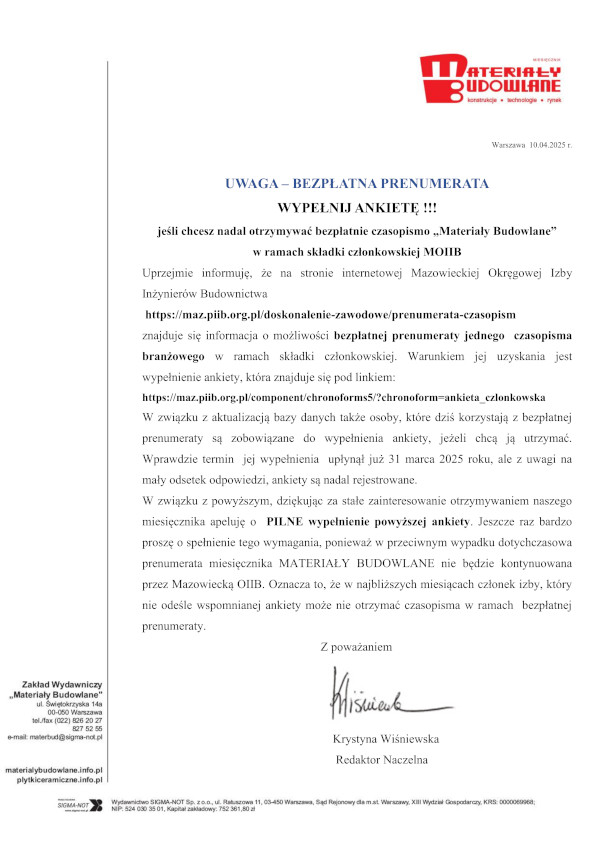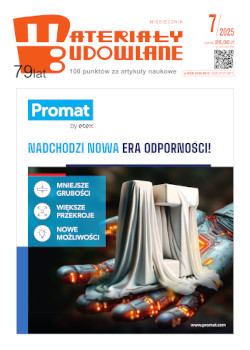Open Access (Artykuł w pliku PDF)
Using the energy absorption capacity to determine the residual strength of fibrocomposites
prof. dr hab. inż. Wiesława Głodkowska, Politechnika Koszalińska, Wydział Inżynierii Lądowej, Geodezji i Środowiska
ORCID: 0000-0003-3719-5350
dr inż. Joanna Laskowska-Bury, Politechnika Koszalińska, Wydział Inżynierii Lądowej, Geodezji i Środowiska
ORCID: 0000-0002-0618-1370
dr inż. Marek Lehmann, Politechnika Koszalińska, Wydział Inżynierii Lądowej, Geodezji i Środowiska
ORCID: 0000-0002-1314-3014
Adres do korespondencji: Ten adres pocztowy jest chroniony przed spamowaniem. Aby go zobaczyć, konieczne jest włączenie w przeglądarce obsługi JavaScript.
DOI: 10.15199/33.2023.03.01
Doniesienie naukowe
Streszczenie. W artykule omówiono sposób wyznaczania wytrzymałości resztkowych z wykorzystaniem zdolności pochłaniania energii przez fibrokompozyt. Badania przeprowadzono przez zginanie płyt o przekroju kwadratowym podpartych przegubowo na obwodzie. Określone w ten sposób wytrzymałości resztkowe cechują się znacznie mniejszym współczynnikiem zmienności niż wyznaczone wg PN-EN 14651:2007. Opisane badanie jest alternatywą dla 3-punktowego zginania belek i pozwala na wyznaczenie tej cechy z większą wiarygodnością.
Słowa kluczowe: fibrokompozyt; włókna stalowe; zdolność pochłaniania energii; wytrzymałości resztkowe.
Abstract. The article discusses the method of determining residual strength using the energy absorption capacity of fibrecomposite. The research was carried out by bending squarecross- section plates simply supported at the perimeter. The residual strengths determined in this way are characterized by a much lower coefficient of variation than those determined using the normative method according to PN-EN 14651:2007. The described test is an alternative to 3-point bending of beams and allows to determine this feature with greater reliability.
Keywords: fiber-reinforced composite; steel fibers; energy absorption ability; residual strength.
Literatura
[1] Tiberti G, Germano F, Mudadu A, Plizzari GA. An overview of the flexural post–cracking behavior of steel fiber reinforced concrete. Struct Concr. 2017; 19: 695 – 718.
[2] Buratti N, Ferracuti B, Savoia M. Concrete crack reduction in tunnel linings by steel fibre–reinforced concretes. Constr Build Mater. 2013; 44: 249 – 259.
[3] Głodkowska W. Waste Sand Fiber Composite: Models of Description of Properties and Application. Annu. Set The Environ Prot. 2018; 20: 291.
[4] Giaccio G, Tobes JM, Zerbino R. Use of small beams to obtain design parameters of fibre reinforced concrete. CemConcr Comp. 2008; 30: 297 – 306.
[5] Model Code 2010. In Final draft, fib Bulletin 66, v. 2, 2012. Comite Euro-International du Beton – Federation International e de la Precontrainte: Paris; 2010.
[6] PN-EN 14651:2005 + A1:2007. Test Method for Metallic Fibered Concrete – Measuring the Flexural Tensile Strength (Limit or Proportionality (LOP), Residual).
[7] RILEM TC 162-TDF. Test and design methods for steel fibre reinforced concrete, σ-ε design method. Mater Struct. 2003; 36: 560 – 567.
[8] Yoo DY, Lee JH, Yoon YS. Effect of fiber content on mechanical and fracture properties of ultrahigh performance fiber reinforced cementitious composites. Com Struct 2013; 106: 742 – 753.
[9] Lee JH. Influence of concrete strength combined with fiber content in the residual flexural strengths of fiber reinforced concrete. Compos Struct. 2017; 168: 216 – 225.
[10] Zamanzadeh Z, Laurenco L, Barros J. Recycled steel fiber reinforced concrete failing in bending and in shear. Constr Build Mater. 2015; 85: 195 – 207.
[11] ChoiWCh, Jung KY, Jang SJ, Yun HD. The Influence of Steel Fiber Tensile Strengths and Aspect Ratios on the Fracture Properties of High-Strength Concrete. Materials. 2019; 12: 2105.
[12] Centonze G, Leone M, Aiello MA. Steel fibers from waste tires as reinforcement in concrete: a mechanical characterization. Constr Build Mater. 2012; 36: 46 – 57.
[13] Buratti N, Mazzotti C, Savoia M. Postcracking behaviour of steel and macro synthetic fiber-reinforced concretes. Constr Build Mater. 2011; 25: 2713 – 2722.
[14] Głodkowska W, Ziarkiewicz M, Lehmann M. Residual strength of fibre composite based on waste sand. Materiały Budowlane. 2015; 5: 75 – 77.
[15] PN-EN 14488-5: 2008. Testing sprayed concrete – Part 5: Determination of energy absorption capacity of fibre reinforced slab specimens.
[16] Lehmann M, Głodkowska W. Shear Capacity and Behaviour of Bending Reinforced Concrete Beams Made of Steel Fibre- Reinforced Waste Sand Concrete. Materials. 2021; 14: 2996.
[17] Laskowska-Bury J. Wybrane cechy fizyko- -mechaniczne fibrokompozytu wytworzonego na bazie kruszywa odpadowego. Rozprawa doktorska. Koszalin; 2017.
[18] Khaloo AR, Afshari M. Flexural behaviour of small steel fibre reinforced concrete slabs. Cem Concr Comp. 2005; 27: 141 – 149.
Przyjęto do druku: 17.02.2023 r.
Materiały Budowlane 03/2023, strona 1-4 (spis treści >>)






























